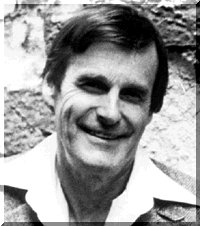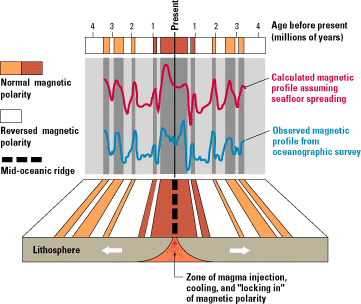
(Image: Ontario Association of Remote Sensing)
Biographical Information
Lawrence Morley was born in Toronto, Ontario in 1920. He studied physics and geology at the University of Toronto, with an interruption to fight in World War II. After returning from the war he graduated in 1946, then continued on to graduate studies earning both a masters degree and a PhD in geophysics. He spent much of his graduate career focusing on paleomagnetism, a field he would continue to pursue in his professional career.
Specific contribution to plate tectonic theory / solid Earth geophysics
In an attempt to explain the continental drift theories proposed by Harry Hess and Alfred Wegner, Morley presented the idea that there was a magnetic pattern of igneous rock on the ocean floor. His hypothesis took into account that new magma rising up at a mid-ocean ridge contains iron (ferromagnetic minerals) in its composition, and the rocks magnetic elements would be locked in place at the current magnetic position. Over time on Earth the magnetic poles reverse, locking the new elements in the rock at the mid-ocean ridge in the opposite orientation. This alternating pattern of reverse and normal polarity in the rock of the ocean floor was discovered and explained by Morley (figure 1). Dr. Morley used his evidence to explain the hypothesis proposed by Alfred Wegner, a hypothesis that Wegner could not solidly prove in his time.

Figure 1 (USGS)
His research with ocean floor magnetic surveys coincided with other research in this field and his proposed hypothesis of magnetic banding on the ocean floor was independently proposed by two other scientists as well, Fredrick Vine and Drummond Hoyle Matthews. The 1963 theory of magnetic reversals on the ocean floor is sometimes referred to as the Morley-Vine-Matthews hypothesis.
Much of the later research in his career focused on mapping the continents and oceans by using remote sensing techniques. He used satellites to map much of Canada for geologic and spatial data. The focus on remote sensing lead him away from the field of geomagnetism, but he still had the desire to enhance his theory of ocean floor magnetic banding, and was always looking for new technology to enhance data collection in this area. “I believe, however, that there still is a wealth of unexpected information magnetically frozen in the rocks of the ocean basin floors and that extensive, high-quality three-component magnetic gradiometer surveys are the most cost-effective way of getting at it.” (Morley, p.23)
Other interesting scientific contributions
· Created remote sensing techniques to map the Earth’s surface from satellites and aircraft.
· Enhanced other remote sensing techniques to map the ocean floor.
Notable Professional Achievements and Awards:
· Appointed director of the Geophysics Branch of the Geological Survey of Canada (1950–1969)
· Completed aeromagnetic surveys of Canada as Chief of the Geophysics Division of the Geologic Survey of Canada, creating over 7,000 maps, from which billions of dollars of valuable minerals were discovered (1952-1969)
· Founded the Canada Centre for Remote Sensing in 1970 and served as director until 1979
· Founded the Institute for Space and Terrestrial Science (ISTS) in 1986
· Received the Gold Medal Award from the Royal Canadian Geographical Society in 1995
Other cool stuff you should know
· Served as a radar officer in the Royal Canadian Navy during World War II.
· Felt his 1963 theory was “unsuccessful” based on not getting his work published before Vine and Matthews. (Morley, p.23)
· Took a twenty two year break from the field of geomagnetism to focus on remote sensing. (Morley, p.23)
Bibliography
Morley, Lawrence W. “The role of magnetic surveying in developing the concept of plate tectonics.” Tectonophysics, Volume 187, Issues 1-3, 20 February 1991, Pages 23-25
Wikipedia, Lawrence Morley. http://en.wikipedia.org/wiki/Lawrence_Morley
United States Geologic Survey (USGS), http://pubs.usgs.gov/gip/dynamic/stripes.html
Ontario Association of Remote Sensing (OARS), http://www.oars.on.ca/honorary/morley.php